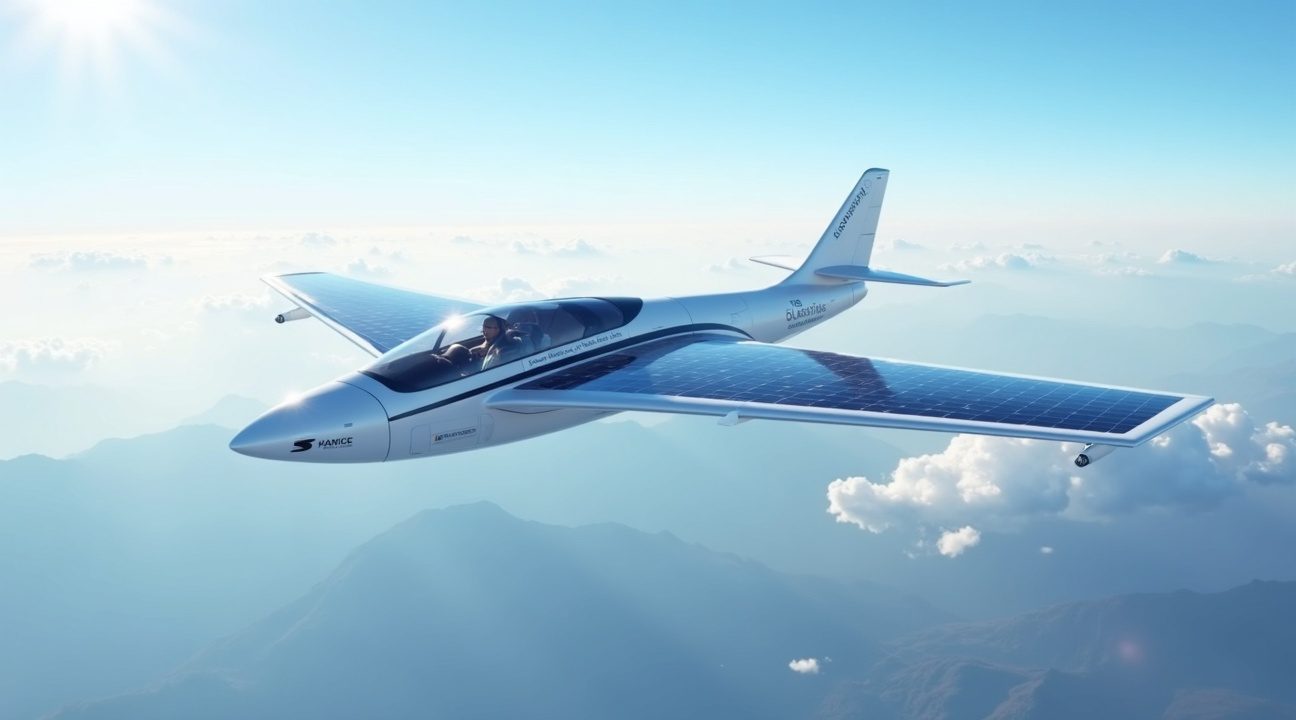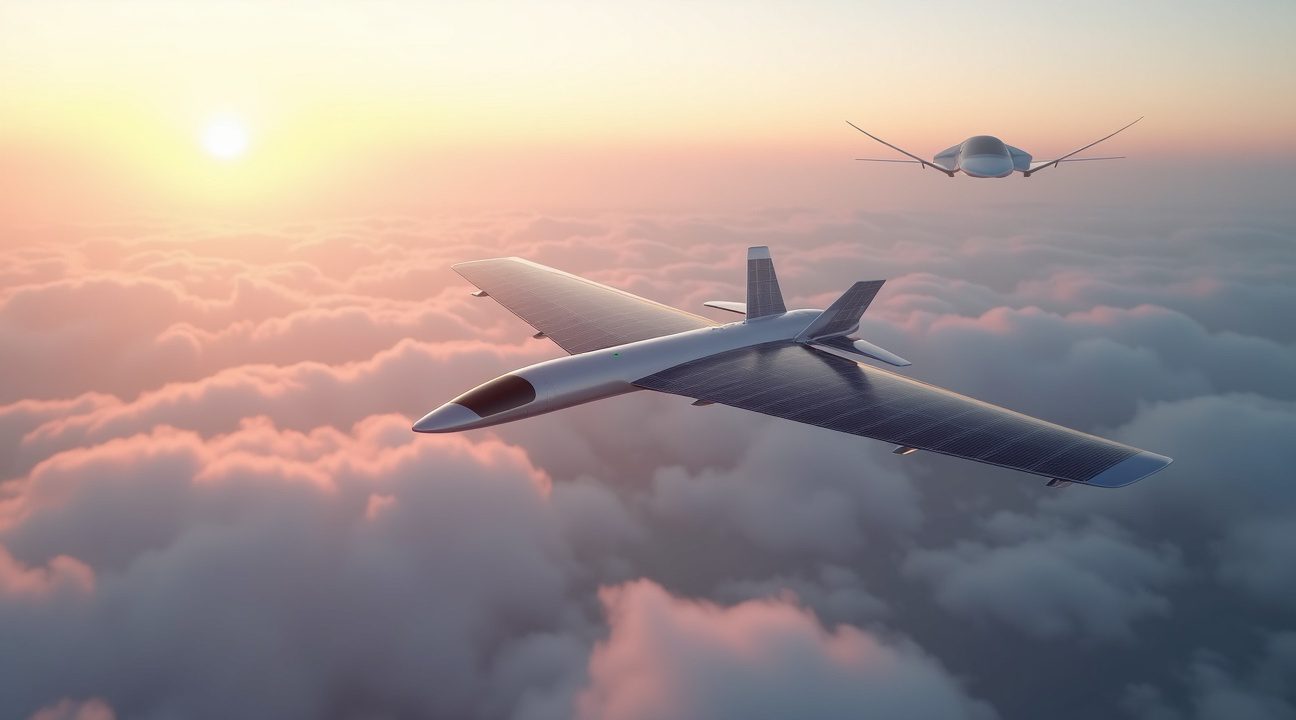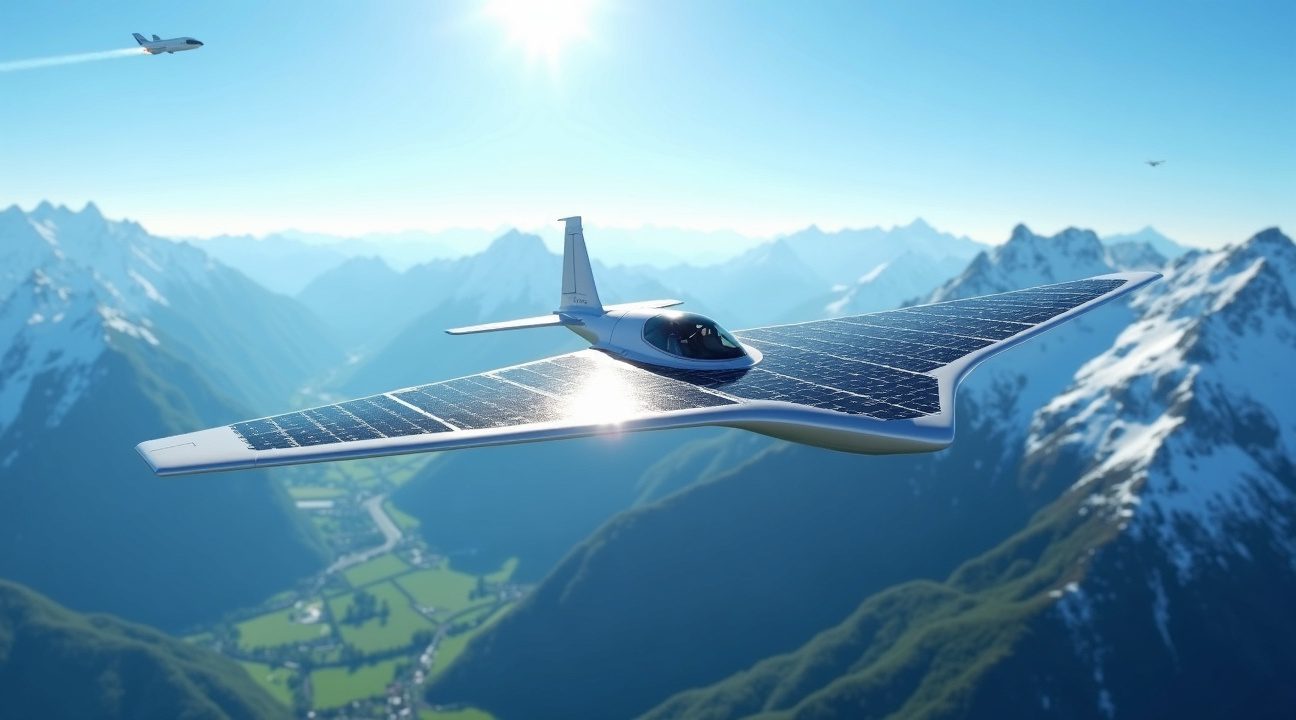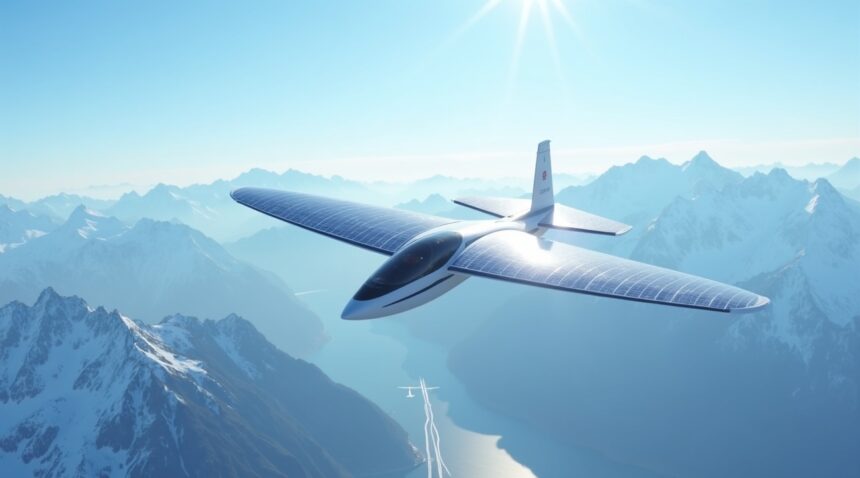Swiss pilot Raphaël Domjan made aviation history on August 12, 2025, when he piloted the SolarStratos HB-SXA aircraft to a record-breaking altitude of 31,237 feet, powered entirely by solar energy.
This remarkable accomplishment surpassed the previous solar-powered flight altitude record of 30,298 feet, a record that stood for 15 years. The success of the SolarStratos mission proves that sustainable and renewable energy technologies in aviation are reaching new heights—literally—by operating at the altitudes where commercial airliners fly.
Key Takeaways
- Efficient Design: SolarStratos reached the new world record with only 22 square meters of solar panels, a stark contrast to the 200 square meters used by Solar Impulse during its 2010 flight.
- Real-Time Energy Management: The aircraft met strict energy requirements, producing power in real-time and maintaining a mandatory 16% battery reserve to ensure a safe landing.
- Strategic Flight Plan: The 5-hour, 9-minute flight used a phased approach—first leveraging thermal currents, then charging at mid-altitudes—to accumulate energy before making the final climb.
- Seamless Airspace Integration: The flight occurred in the same altitude range as commercial jetliners, showcasing that solar-powered aircraft can integrate within conventional aviation systems.
- Future Aspirations: Marking a milestone for sustainable aviation, the SolarStratos team now prepares to pursue stratospheric flight above 32,808 feet.
More About the Mission
The SolarStratos project aims to push the boundaries of green aviation while raising global awareness about the potential of renewable energy. As highlighted in this official SolarStratos link, the team’s goal is not only scientific achievement but also ecological impact, showing that solar-powered aviation is not a dream but a present-day reality.
With its recent record, the SolarStratos HB-SXA and Raphaël Domjan have brought us one step closer to a future where clean energy powers not only homes and vehicles but the sky itself.
Swiss Pilot Soars to Record-Breaking 31,237 Feet in Solar-Powered Aircraft
On August 12, 2025, aviation history changed forever when Swiss pilot Raphaël Domjan pushed the boundaries of solar-powered flight. I witnessed a remarkable achievement as he guided the SolarStratos HB-SXA aircraft to an unprecedented altitude of 9,521 meters (31,237 feet), establishing a new world record for solar-powered manned aviation.
This extraordinary accomplishment shattered the previous benchmark that had stood unchallenged for nearly 15 years. André Borschberg set the former record in 2010 when he reached 9,235 meters (30,298 feet) flying the Solar Impulse plane. Domjan’s achievement represents a significant leap forward, climbing an additional 286 meters higher than any solar-powered aircraft had previously reached with a pilot aboard.
Technical Achievement and Flight Details
The record-breaking flight originated from Sion airport in southwest Switzerland, where optimal conditions aligned perfectly for this ambitious undertaking. Domjan expertly utilized warm air thermals to propel the aircraft above the majestic Alps, demonstrating both pilot skill and aircraft capability. The flight’s impressive duration of 5 hours and 9 minutes showcased the remarkable endurance and efficiency that modern solar-powered aviation technology can achieve.
At cruising altitude, something particularly significant occurred – Domjan’s flight intersected the same airspace occupied by commercial jetliners. This symbolic moment highlighted the genuine potential for decarbonized aviation solutions. While suborbital flights capture headlines for speed, solar-powered aircraft like the SolarStratos demonstrate sustainable alternatives for future aviation.
The SolarStratos aircraft itself represents cutting-edge engineering in renewable aviation technology. Unlike traditional aircraft that rely on fossil fuels, this innovative machine harnesses solar energy to power its ascent and sustained flight. The successful navigation above 31,000 feet proves that solar technology has matured enough to compete with conventional aviation standards.
Switzerland’s leadership in this field isn’t accidental. The country has consistently invested in sustainable aviation research, building on the legacy established by the Solar Impulse project. This latest achievement reinforces Switzerland’s position as a pioneer in clean energy aviation solutions.
Domjan’s record flight occurred during ideal weather conditions, with clear skies maximizing solar panel efficiency. The pilot’s expertise in reading thermal patterns and managing energy consumption proved crucial for reaching such extraordinary heights. His achievement opens new possibilities for future aircraft development and sustainable transportation solutions.
This breakthrough demonstrates that solar-powered aviation has evolved from experimental technology into a viable platform capable of reaching commercial aviation altitudes. The 31,237-foot achievement marks a pivotal moment where renewable energy aviation transitions from possibility to reality.
https://www.youtube.com/watch?v=CEK_yd4ZsZLZAM
Technical Specifications That Made History Possible
The SolarStratos HB-SXA represents a remarkable feat of engineering precision, combining cutting-edge materials with innovative solar technology. This experimental solar-electric aircraft measures 9.6 meters in length with an impressive wingspan of 24.8 meters, creating the optimal platform for sustained high-altitude flight powered entirely by the sun.
Advanced Solar Integration and Construction
Solar energy capture drives every aspect of this aircraft’s design philosophy. The wings incorporate 22 square meters of high-specification solar panels, strategically positioned for maximum sunlight exposure throughout the flight envelope. These panels must generate sufficient power to maintain flight operations while simultaneously charging the aircraft’s battery systems for sustained operation.
Carbon fiber construction forms the backbone of the SolarStratos, delivering exceptional strength while maintaining minimal weight. This material choice proves essential for achieving the delicate balance between structural integrity and energy efficiency required for solar-powered flight. Every component reflects careful consideration of weight versus performance, ensuring optimal energy utilization from the solar collection system.
Performance Parameters and Regulatory Requirements
Flight performance specifications reveal the aircraft’s capabilities across various operational phases:
- Maximum speed: reaches 140 km/h under optimal conditions
- Cruising speed: maintains approximately 80 km/h for efficient long-duration flight
- Take-off speed: begins at 50 km/h, enabling operations from shorter runways
- Energy source: all flight energy must be produced in real-time by the solar cell array
Strict operational requirements govern record attempts to ensure legitimate achievements. The aircraft must land under its own power while maintaining at least 16% battery charge, eliminating any possibility of gliding to touchdown. This requirement demonstrates the system’s complete energy independence and sustainable operation throughout the entire flight profile.
The World Air Sports Federation (FAI) oversees record validation, applying rigorous standards for altitude measurement. Official records utilize pressure altitude corrected to standard density altitude, ensuring accurate and comparable measurements across different atmospheric conditions and geographic locations.
This solar aviation breakthrough connects to broader developments in sustainable flight technology, similar to innovations seen in flying car technology and NASA’s suborbital flight programs. The success of the SolarStratos demonstrates how renewable energy integration can push aviation boundaries while maintaining environmental responsibility.
Real-time solar power generation eliminates dependence on stored energy beyond the mandatory landing reserve, showcasing the viability of direct solar propulsion for sustained flight operations. This achievement marks a significant milestone in sustainable aviation development.

Strategic Flight Preparation and Execution
The path to this remarkable altitude achievement required careful preparation and precise execution strategies. I observed how the Swiss team approached this challenge through a series of calculated test flights that gradually pushed the boundaries of solar-powered aviation.
The preparatory phase included a crucial warm-up flight on July 31, 2025, where the aircraft successfully reached 6,589 meters. This preliminary flight served as both a systems check and a confidence builder, demonstrating that the solar-powered aircraft could handle significant altitude gains while maintaining stable flight characteristics. Earlier attempts had shown the critical importance of favorable thermals and optimal battery management, two factors that would prove essential for the record-breaking flight.
Multi-Phase Climbing Strategy
The team developed a sophisticated climbing strategy that maximized both solar energy collection and natural atmospheric conditions. The approach involved several distinct phases:
- Initial ascent using combined solar energy and thermal currents to reach 4,000–5,000 meters
- Extended flight at this intermediate altitude to recharge batteries using solar panels
- Strategic positioning to capture optimal thermal activity
- Final powered climb to the record-breaking altitude using fully charged battery reserves
- Continuous monitoring of energy consumption throughout each phase
This methodical approach allowed the aircraft to build energy reserves at altitude rather than relying solely on ground-level charging. The intermediate altitude phase proved particularly valuable, as solar collection efficiency increases significantly above the lower atmospheric layers where clouds and atmospheric disturbances can interfere with direct sunlight.
The unique combination of solar charging and atmospheric exploitation became the cornerstone of the successful flight strategy. Unlike traditional aircraft that must carry all their fuel from takeoff, this solar-powered plane could actively generate energy during flight while simultaneously taking advantage of rising air currents. The team’s ability to read atmospheric conditions and time the final ascent perfectly demonstrated the sophisticated planning required for such an ambitious undertaking.
Battery management systems played a crucial role throughout the preparation and execution phases. The aircraft’s energy storage had to maintain optimal performance at varying altitudes and temperatures, requiring extensive testing of thermal management systems. The team discovered that battery efficiency actually improved at higher altitudes due to cooler temperatures, providing an unexpected advantage during the record attempt.
Weather pattern analysis became another critical component of the preparation process. The Swiss team worked closely with meteorological services to identify optimal flight windows when thermal activity would be strongest and atmospheric conditions most stable. This collaboration proved essential, as the success of suborbital flights and high-altitude aviation often depends on precise timing.
The execution phase required real-time decision-making as conditions changed throughout the flight. Pilots had to balance energy conservation with altitude gains, making split-second decisions about when to rely on thermals versus battery power. The flight team maintained constant communication with ground support, monitoring everything from solar panel output to atmospheric pressure changes.
Ground support teams tracked the aircraft’s progress using advanced telemetry systems that provided real-time data on energy consumption, battery status, and atmospheric conditions. This information proved invaluable for making tactical decisions during the climb phases and ensuring the aircraft maintained optimal performance throughout the record attempt.
The success of this strategic approach opens new possibilities for future solar aviation achievements. The demonstrated ability to recharge at altitude while maintaining flight operations suggests that even longer-duration flights may be possible, potentially rivaling the convenience of flying cars for certain applications. The methodical preparation and execution strategy developed by the Swiss team provides a blueprint for future high-altitude solar flight attempts, proving that careful planning and innovative energy management can overcome the traditional limitations of solar-powered aviation.
SolarStratos vs Solar Impulse: A New Generation of Solar Flight
Switzerland’s recent achievement with SolarStratos marks a significant evolution in solar aviation technology, surpassing the previous altitude record set by Solar Impulse over a decade ago. In 2025, pilot Raphaël Domjan piloted SolarStratos to an impressive 9,521 meters (31,237 feet), breaking the altitude record previously held by Solar Impulse’s 9,235 meters (30,298 feet) achieved by André Borschberg in 2010.
The technical specifications reveal fascinating contrasts between these two solar aircraft generations. SolarStratos operates with remarkably compact dimensions — just 9.6 meters in length with a 24.8-meter wingspan and only 22 square meters of solar cell coverage. Solar Impulse, by comparison, featured much larger proportions with its 21.85-meter length, massive 63.4-meter wingspan, and extensive 200 square meters of solar cells.
Performance Under Stricter Energy Constraints
What makes SolarStratos’s achievement particularly remarkable is its operation under significantly more restrictive energy management rules. The aircraft must rely on real-time solar power generation and maintain a minimum 16% battery reserve for safe landing procedures. These constraints require exceptional energy efficiency and precise flight planning that wasn’t demanded of earlier solar aircraft designs.
The performance disparity becomes even more striking when considering the vast difference in solar collection capability:
- SolarStratos achieved superior altitude performance
- Approximately nine times fewer solar cells than Solar Impulse
This dramatic improvement demonstrates how advances in photovoltaic efficiency, battery technology, and aerodynamic design have revolutionized solar flight capabilities over the past fifteen years.
Modern solar aviation benefits from:
- Lighter composite materials
- More efficient electric motors
- Significantly improved solar cell conversion rates
Aerospace innovations continue pushing the boundaries of what’s possible with alternative propulsion systems. SolarStratos represents this new generation of solar aircraft that achieves more with less, proving that efficient design can overcome raw solar collection area.
The energy management protocols governing SolarStratos also reflect a more practical approach to solar aviation. By requiring real-time solar dependency and maintaining landing reserves, these rules better simulate the constraints that commercial solar aircraft would face. This approach contrasts with earlier demonstrations that allowed more flexible energy management strategies.
Both aircraft contribute valuable insights to the future of sustainable aviation. While Solar Impulse proved solar flight’s long-distance potential with its around-the-world journey, SolarStratos demonstrates that compact, efficient designs can achieve impressive altitude performance under operational constraints that mirror real-world flying conditions.

Mission Beyond Records: Inspiring Sustainable Aviation
I find it remarkable that the SolarStratos team views their record-breaking achievement as just the beginning of a much larger mission. Their primary aim extends far beyond breaking altitude records – they’re working to inspire sustainable innovation and demonstrate to young generations that flight without fossil fuels and carbon emissions isn’t just possible, but practical.
The team’s vision aligns with broader developments in sustainable transportation, including innovations like flying cars and advanced suborbital flights that could revolutionize travel. Raphael Domjan, the project’s pilot, has his sights set on even more ambitious goals. He’s preparing to break the 10,000-meter (32,808 feet) barrier, pushing into true stratospheric altitudes where commercial airliners routinely cruise.
The ultimate target represents a historic first: becoming the first aircraft to enter the stratosphere powered entirely by solar energy. Over Switzerland, the stratosphere begins at approximately 12,000 meters, making this an extraordinarily challenging technical feat. Success would demonstrate that clean aviation technology can operate in the same airspace as conventional aircraft.
Building on Proven Success
The SolarStratos project didn’t emerge from nowhere. Since launching in 2015, it has built on the record-setting legacy of the 2012 PlanetSolar solar catamaran. This maritime predecessor proved that solar power could sustain long-distance travel across the world’s oceans, providing crucial technical foundation for the aviation project.
The progression from water to air represents a natural evolution in sustainable transportation technology. Each milestone achieved by the SolarStratos team opens new possibilities for commercial space flights and other advanced aviation concepts. Unlike traditional aerospace development that often faces setbacks like failed rocket launches, solar aviation offers a more predictable development path.
The educational impact can’t be overstated. Young engineers and pilots watching these achievements understand that sustainable aviation isn’t theoretical – it’s happening now. The team’s success challenges the aviation industry to reconsider fundamental assumptions about power sources and emissions. Their work provides a compelling alternative to the environmental concerns raised about aviation, including criticism of short flights with high emissions.
Each flight pushes the boundaries of what’s considered possible in clean aviation technology. The SolarStratos project serves as a proving ground for innovations that could eventually transform commercial aviation, making zero-emission flight a reality rather than an aspiration.
https://www.youtube.com/watch?v=jygDOyDrK9c

Significance for Aviation’s Sustainable Future
This groundbreaking achievement by SolarStratos marks a pivotal moment for aviation’s transition into a cleaner, more sustainable era. I view this milestone as proof that renewable energy technology has matured enough to power aircraft at altitudes previously reserved for conventional fuel-powered planes. The fact that a solar-powered aircraft successfully operated at commercial aviation altitudes demonstrates the viability of alternative propulsion systems in real-world conditions.
Bridging Solar Technology with Commercial Aviation
SolarStratos crossing paths with commercial airliners at 31,000 feet provides compelling evidence that solar aviation technology can integrate with existing air traffic systems. This intersection of solar-powered flight with traditional aviation infrastructure suggests that hybrid approaches could emerge, where conventional aircraft might incorporate solar technology for auxiliary power or specific flight phases. I see this development as particularly significant because it proves solar aircraft can operate safely in controlled airspace alongside commercial traffic.
The achievement also highlights how flying car technology and other innovative aircraft designs are pushing boundaries across multiple aviation sectors. While NASA continues testing suborbital flights for rapid global travel, solar aviation offers a different path focused on sustainability rather than speed.
Regulatory Evolution Supporting Alternative Aviation
The timing of this record coincides with significant regulatory changes that support innovative aircraft designs. MOSAIC regulations in the United States are creating pathways for electric, hydrogen, and other unconventional propulsion systems to enter commercial aviation markets. I believe these regulatory frameworks will accelerate the adoption of sustainable aviation technologies demonstrated by achievements like SolarStratos.
The aviation industry’s growing focus on decarbonization makes solar-powered flight increasingly relevant for future transportation strategies. Unlike commercial space flights that consume massive amounts of fuel, solar aviation offers zero-emission flight capabilities that align with global climate goals. This technological advancement comes at a time when the industry faces pressure to reduce emissions, making solar power an attractive complement to traditional propulsion methods.
Even as setbacks occur in aerospace innovation, such as recent rocket launch failures, solar aviation continues advancing steadily. I expect this consistent progress to position solar technology as a viable option for specific aviation applications, particularly in regional transport and specialized mission profiles where sustainability outweighs speed requirements.
Sources:
Gulf News: “Swiss pilot surpasses solar-powered plane altitude record”
CBS News: “Pilot breaks altitude record for solar-powered plane”
Aerospace Global News: “SolarStratos: Solar-powered aircraft smashes altitude record”
SWI swissinfo.ch: “Swiss solar plane claims altitude record”
TechXplore: “Swiss pilot surpasses solar-powered plane altitude record”
Flying Magazine: “Pilot Claims Altitude Record for Electric Solar Plane”
Wikipedia: “Solar Impulse”


